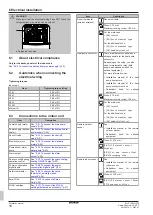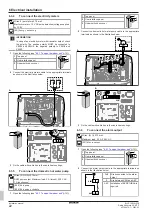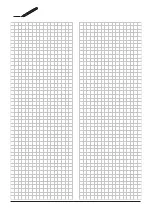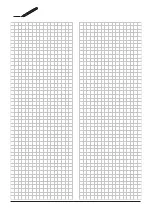
7 Configuration
Installation manual
32
EL23E
Daikin Altherma 3 R MT F
4P708476-1 – 2023.03
#
Code
Description
[3.1]
N/A
▪ 0:
No
▪ 1:
Yes
7.2.7
Configuration wizard: Tank
INFORMATION
To make tank defrost possible, we recommend a minimum
tank temperature of 35°C.
Heat up mode
The domestic hot water can be prepared in 3 different ways. They
differ from each other by the way the desired tank temperature is set
and how the unit acts upon it.
#
Code
Description
[5.6]
[6-0D]
Heat up mode
:
▪ 0:
Reheat
only
: Only reheat
operation is allowed.
▪ 1:
Sc reheat
: The domestic
hot water tank is heated according to a
schedule and between the scheduled
heat up cycles, reheat operation is
allowed.
▪ 2:
Schedule only
: The domestic hot
water tank can ONLY be heated
according to a schedule.
See the operation manual for more details.
Settings for Reheat only mode
During Reheat only mode, the tank setpoint can be set on the user
interface. The maximum allowed temperature is determined by the
following setting:
#
Code
Description
[5.8]
[6-0E]
Maximum
:
The maximum temperature that users
can select for the domestic hot water.
You can use this setting to limit the
temperature at the hot water taps.
The maximum temperature is NOT
applicable during disinfection function.
See disinfection function.
To set the heat pump ON hysteresis:
#
Code
Description
[5.9]
[6-00]
Heat pump ON hysteresis
▪ 2°C~40°C
Settings for Schedule only mode and Sc reheat mode
Comfort setpoint
Only applicable when domestic hot water preparation is
Schedule
only
or
Sc reheat
. When programming the schedule, you
can make use of the comfort setpoint as a preset value. When you
later want to change the storage setpoint, you only have to do it in
one place.
The tank will heat up until the
storage comfort temperature
has
been reached. It is the higher desired temperature when a storage
comfort action is scheduled.
Additionally, a storage stop can be programmed. This feature puts a
stop to tank heating even if the setpoint has NOT been reached.
Only program a storage stop when tank heating is absolutely
undesirable.
#
Code
Description
[5.2]
[6-0A]
Comfort setpoint
:
▪ 30°C~[6‑0E]°C
Eco setpoint
The
storage economic temperature
denotes the lower desired
tank temperature. It is the desired temperature when a storage
economic action is scheduled (preferably during day).
#
Code
Description
[5.3]
[6-0B]
Eco setpoint
:
▪ 30°C~min(50,[6‑0E])°C
Reheat setpoint
Desired reheat tank temperature
, used:
▪ in
Schedule
+
reheat
mode, during reheat mode: the
guaranteed minimum tank temperature is set by the
Reheat
setpoint
minus the reheat hysteresis. If the tank temperature
drops below this value, the tank is heated up.
▪ during storage comfort, to prioritize the domestic hot water
preparation. When the tank temperature rises above this value,
domestic hot water preparation and space heating/cooling are
executed sequentially.
#
Code
Description
[5.4]
[6-0C]
Reheat setpoint
:
▪ 30°C~min(50,[6‑0E])°C
Hysteresis (reheat hysteresis)
Applicable when domestic hot water preparation is scheduled
+reheat. When the tank temperature drops below the reheat
temperature minus the reheat hysteresis temperature, the tank heats
up to the reheat temperature.
#
Code
Description
[5.A]
[6-08]
Reheat hysteresis
▪ 2°C~20°C
7.3
Weather-dependent curve
7.3.1
What is a weather-dependent curve?
Weather-dependent operation
The unit operates 'weather-dependent' if the desired leaving water or
tank temperature is determined automatically by the outdoor
temperature. It therefore is connected to a temperature sensor on
the North wall of the building. If the outdoor temperature drops or
rises, the unit compensates instantly. Thus, the unit does not have to
wait for feedback by the thermostat to increase or decrease the
temperature of the leaving water or tank. Because it reacts more
quickly, it prevents high rises and drops of the indoor temperature
and water temperature at tap points.
Advantage
Weather-dependent operation reduces energy consumption.
Weather-dependent curve
To be able to compensate for differences in temperature, the unit
relies on its weather-dependent curve. This curve defines how much
the temperature of the tank or leaving water must be at different
outdoor temperatures. Because the slope of the curve depends on
local circumstances such as climate and the insulation of the
building, the curve can be adjusted by an installer or user.
Types of weather-dependent curve
There are 2 types of weather-dependent curves:
▪ 2-points curve
















































